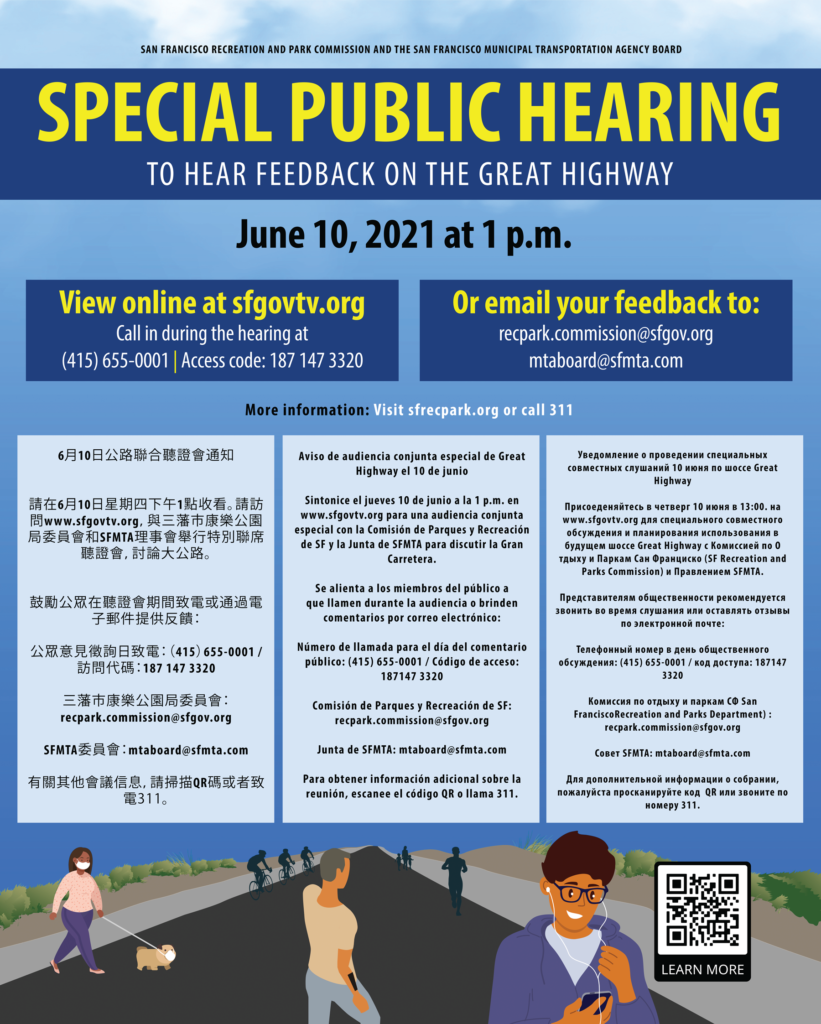
The pandemic has taken a terrible toll on San Franciscans. To save lives, San Francisco adopted strict quarantine measures. These measures successful in reducing the pandemic’s toll. However the necessary isolation and quarantining frayed our social and familial bonds, and eroded our health, happiness, and security.
The City used the pandemic emergency order to provide some car-free public space for physically-distanced movement and recreation. In April 2020, the Great Highway, which runs along Ocean Beach and separates San Francisco from its shoreline, was closed to autos and became a Great Walkway. The public commons on Great Highway and on JFK Drive in Golden Gate Park have been tremendously popular, and, along with Slow Streets and Shared Spaces, have contributed positively to our public life, our health, and progress towards a sustainable future.
These roads were transformed from High-Injury Corridors – the 13% of streets for 75% of serious and deadly crashes take place – to safe places for San Franciscans of all ages and abilities to recreate and socialize along the City’s ocean front and in our City’s largest park.
On Thursday June 10 at 1 pm, the Recreation and Parks Commission and SFMTA Board of Directors will hold a joint hearing on the future of the Great Highway. They will consider various options, including keeping the former highway open to people while they complete a long-term plan for use of the space.
We support making Great Highway and JFK Drive permanently car-free. San Francisco deserves a great public waterfront. Removing the Embarcadero Freeway three decades ago transformed our northeastern watefront into one of the City’s most beloved public spaces. Preserving and improving the Great Walkway, and enhancing access to it, promises to create another great public space for San Franciscans, and a positive legacy for future generations.
We have known for decades that keeping Great Highway as-is will ultimately destroy Ocean Beach, but the City has hesitated doing anything about it. The beach and dunes are dynamic, and sand moves onshore and offshore and up and down the beach in response to seasonal storm patterns and longer-term changes like rising sea levels. Each year moving sand closes the roadway during more days of the year. Keeping the waterfront highway just as it is will someday destroy the beach and dune ecosystem, and necessitate an engineered seawall. The Great Walkway will create space for recreation as well as space for the beach and dunes to continue to protect the shore and the adjacent neighborhoods.
Removing highways means sorting out the details of traffic movement and public access. That work has already begun, and will continue. Prior to the pandemic, Great Highway was regularly closed to cars when wind and tides moved sand onto the roadway. The stretch of Great Highway south of Sloat Boulevard will soon be narrowed, and its auto capacity reduced, to retreat from the cliff edge. Allowing auto traffic on Great Highway again will delay adaptation to the changing shoreline, and limit public enjoyment of the waterfront and further damage to the beach ecosystem in the meantime.
Let the SFMTA and Recreation and Parks commission know you support keeping the Great Walkway as a permanent car-free people space while they continue to improve public access and traffic movement.
You can email both boards (MTABoard@SFMTA.com, recpark.commission@sfgov.org) and attend the public hearing online on June 10.





